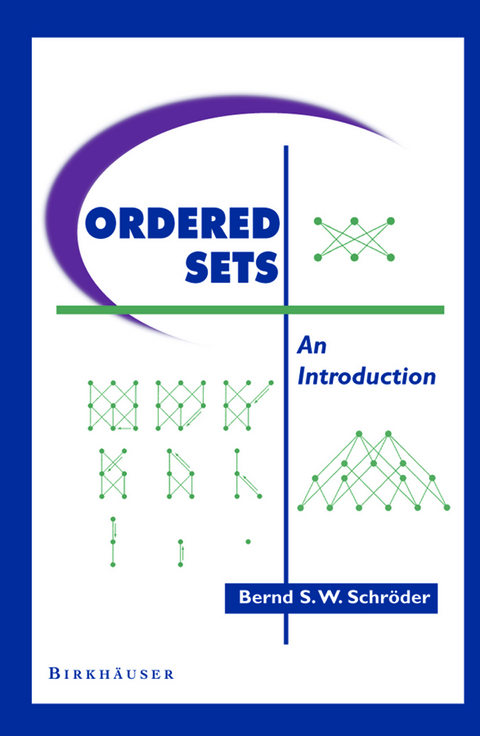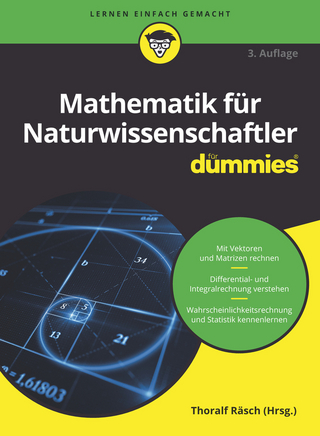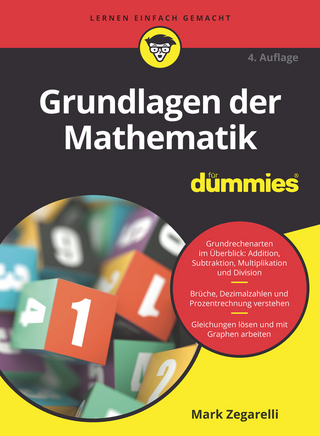
Ordered Sets
Springer-Verlag New York Inc.
978-1-4612-6591-7 (ISBN)
- Titel erscheint in neuer Auflage
- Artikel merken
A wide range of material is presented, from classical results such as Dilworth's, Szpilrajn's and Hashimoto's Theorems to more recent results such as the Li--Milner Structure Theorem. Major topics covered include: chains and antichains, lowest upper and greatest lower bounds, retractions, lattices, the dimension of ordered sets, interval orders, lexicographic sums, products, enumeration, algorithmic approaches and the role of algebraic topology.
Since there are few prerequisites, the text can be used as a focused follow-up or companion to a first proof (set theory and relations) or graph theory class. After working through a comparatively lean core, the reader can choose from a diverse range of topics such as structure theory, enumeration or algorithmic aspects. Also presented are some key topics less customary to discrete mathematics/graph theory, including a concise introduction to homology for graphs, and the presentation of forward checking as a more efficient alternative to the standard backtracking algorithm. The coverage throughout provides a solid foundation upon which research can be started by a mathematically mature reader.
Rich in exercises, illustrations, and open problems, Ordered Sets: An Introduction is an excellent text for undergraduate and graduate students and a good resource for the interested researcher. Readers will discover order theory's role in discrete mathematics as a supplier of ideas as well as an attractive source of applications.
1 The Basics.- 1.1 Definition and Examples.- 1.2 The Diagram.- 1.3 Order-Preserving Mappings/Isomorphism.- 1.4 Fixed Points.- 1.5 Ordered Subsets/The Reconstruction Problem.- Exercises.- Remarks and Open Problems.- 2 Chains, Antichains and Fences.- 2.1 Chains and Zorn’s Lemma.- 2.2 Well-ordered Sets.- 2.3 A Remark on Duality.- 2.4 The Rank of an Element.- 2.5 Antichains and Dilworth’s Chain Decomposition Theorem.- 2.6 Dedekind Numbers.- 2.7 Fences and Crowns.- 2.8 Connectivity.- Exercises.- Remarks and Open Problems.- 3 Upper and Lower Bounds.- 3.1 Extremal Elements.- 3.2 Covers.- 3.3 Lowest Upper and Greatest Lower Bounds.- 3.4 Chain-Completeness and the Abian-Brown Theorem.- Exercises.- Remarks and Open Problems.- 4 Retractions.- 4.1 Definition and Examples.- 4.2 Fixed Point Theorems.- 4.3 Dismantlability.- 4.4 The Fixed Point Property for Ordered Sets of Width 2 or Height 1.- 4.5 Li and Milner’s Structure Theorem.- 4.6 Isotone Relations.- Exercises.- Remarks and Open Problems.- 5 Lattices.- 5.1 Definition and Examples.- 5.2 Fixed Point Results/The Tarski-Davis Theorem.- 5.3 Embeddings/The Dedekind-MacNeille Completion.- 5.4 Irreducible Points in Lattices.- 5.5 Finite Ordered Sets vs. Distributive Lattices.- 5.6 More on Distributive Lattices.- Exercises.- Remarks and Open Problems.- 6 Truncated Lattices.- 6.1 Definition and Examples.- 6.2 Recognizability and More.- 6.3 The Fixed Clique Property.- 6.4 Triangulations of Sn.- 6.5 Cutsets.- 6.6 Truncated Noncomplemented Lattices.- Exercises.- Remarks and Open Problems.- 7 The Dimension of Ordered Sets.- 7.1 (Linear) Extensions of Orders.- 7.2 Balancing Pairs.- 7.3 Defining the Dimension.- 7.4 Bounds on the Dimension.- 7.5 Ordered Sets of Dimension 2.- Exercises.- Remarks and Open Problems.- 8 Interval Orders.- 8.1Definition and Examples.- 8.2 The Fixed Point Property for Interval Orders.- 8.3 Dedekind’s Problem for Interval Orders and Reconstruction.- 8.4 Interval Dimension.- Exercises.- Remarks and Open Problems.- 9 Lexicographic Sums.- 9.1 Definition and Examples.- 9.2 The Canonical Decomposition.- 9.3 Comparability Invariance.- 9.4 Lexicographic Sums and Reconstruction.- 9.5 An Almost Lexicographic Construction.- Exercises.- Remarks and Open Problems.- 10 Sets PQ = Hom(Q, P) and Products.- 10.1 Sets PQ = Hom(Q, P).- 10.2 Finite Products.- 10.3 Infinite Products.- 10.4 Hashimoto’s Theorem and Automorphisms of Products.- 10.5 Arithmetic of Ordered Sets.- Exercises.- Remarks and Open Problems.- 11 Enumeration.- 11.1 Graded Ordered Sets.- 11.2 The Number of Graded Ordered Sets.- 11.3 The Asymptotic Number of Graded Ordered Sets.- 11.4 The Number of Nonisomorphic Ordered Sets.- 11.5 The Number of Automorphisms.- Exercises.- Remarks and Open Problems.- 12 Algorithmic Aspects.- 12.1 Algorithms.- 12.2 Polynomial Efficiency.- 12.3 NP problems.- 12.4 NP-completeness.- 12.5 So It’s NP-complete.- 12.6 A Polynomial Algorithm for the Fixed Point Property in Graded Ordered Sets of Bounded Width.- Exercises.- Remarks and Open Problems.- A A Primer on Algebraic Topology.- A.l Chain Complexes.- A.2 The Lefschetz Number.- A.3 (Integer) Homology.- A.4 A Homological Reduction Theorem.- Remarks and Open Problems.- B Order vs. Analysis.- B.2 Fixed Point Theorems.- B.3 An Application.- Remarks and Open Problems.- References.
"The author has done the field a service by producing an excellent text strong in the presentation of certain topological aspects of the underlying diagrams, e.g., which should serve the developing community and field well and which can be recommended without reservations as one of the volumes which should grace a poseteer's library whether she is interested only or mainly in the theory of these objects or has directed her gaze towards applications. As a sourcebook of ideas and understanding it will make its mark. And deservedly so." —ZENTRALBLATT MATH
"This book is a most successful introduction to the theory of ordered sets. The range of topics covered is wide yet the exposition is self-contained . . . The focus on open problems makes for enthusiastic writing and provides continuity among the diverse topics that are discussed . . . in each chapter the author proves a solid collection of basic results, presents one or more major theorems with detailed and nontrivial proofs, and states without proof one or two other important results. At the end of every chapter is an ample collection of exercises . . . A novel aspect of [the twelfth] chapter is the presentation of much of the material in terms of constraint satisfaction problems." —MATHEMATICAL REVIEWS
"...surprisingly, despite the extremely basic nature of the subject, this monograph has essentially no competition. But fortunately the first entry proves a gem. Undergraduate mathematics and computer science majors will find the first chapters offering background that will serve them well in many courses. The rest of the book, which features many open problems, constitutes an accessible and stimulating invitation to research . . . Highly recommended." —CHOICE
"There are two groups of people who will primarily profit from the book. First, researchers in the field of ordered sets andlattices and related fields like algebra, graphs, and combinatorics. The book provides an excellent look at the field with numerous remarks including historical remarks and open problems. Second, students who are looking for a PhD topic. The author presents the field of ordered sets in an attractive way and the many open problems presented in the book are invaluable. Mathematicians and computer scientists could use the book as a reference book, too...[T]he book is a success, it presents an in depth and up to date carefully written coverage of ordered sets." —SIGACT NEWS
| Zusatzinfo | XVII, 391 p. |
|---|---|
| Verlagsort | New York |
| Sprache | englisch |
| Maße | 155 x 235 mm |
| Themenwelt | Mathematik / Informatik ► Mathematik ► Allgemeines / Lexika |
| Mathematik / Informatik ► Mathematik ► Algebra | |
| Mathematik / Informatik ► Mathematik ► Geometrie / Topologie | |
| Mathematik / Informatik ► Mathematik ► Graphentheorie | |
| Mathematik / Informatik ► Mathematik ► Logik / Mengenlehre | |
| ISBN-10 | 1-4612-6591-6 / 1461265916 |
| ISBN-13 | 978-1-4612-6591-7 / 9781461265917 |
| Zustand | Neuware |
| Haben Sie eine Frage zum Produkt? |
aus dem Bereich



